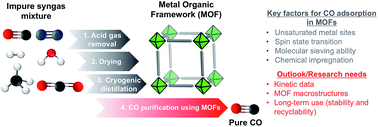The use of metal–organic frameworks for CO purification
Abstract
Carbon monoxide (CO) represents a key feedstock in the petrochemical industry and must be produced in sufficient purity for industrial use. Such requirement imposes strict performance targets on separation technologies and processes employed to purify CO. An important consideration, adding further difficulty to this separation, is the chemical complexity of some CO-containing streams which include gas molecules such as H2, CO2, N2, H2O. While processes such as cryogenic distillation and/or absorption can be applied, the associated high-energy consumption and/or poor stability of the absorption solvents remain key barriers and considerations in large-scale deployment. In this review, we provide an up-to-date account of the literature on adsorption technologies for CO purification with particular emphasis on the use of metal–organic frameworks (MOFs). We highlight key chemical and structural features of MOFs which govern the adsorption mechanisms as well as the resulting performance metrics (e.g. uptake and selectivity). We discuss important aspects of technology scale-up including sorbent robustness, manufacturability and performance under ‘real’ conditions. A comparison of literature reported adsorbents, tested for CO adsorption, including a benchmark material is provided. Based on our analysis of the field, we present an outlook of future challenges as well as opportunities for future research in this area.

- This article is part of the themed collection: Recent Review Articles


 Please wait while we load your content...
Please wait while we load your content...